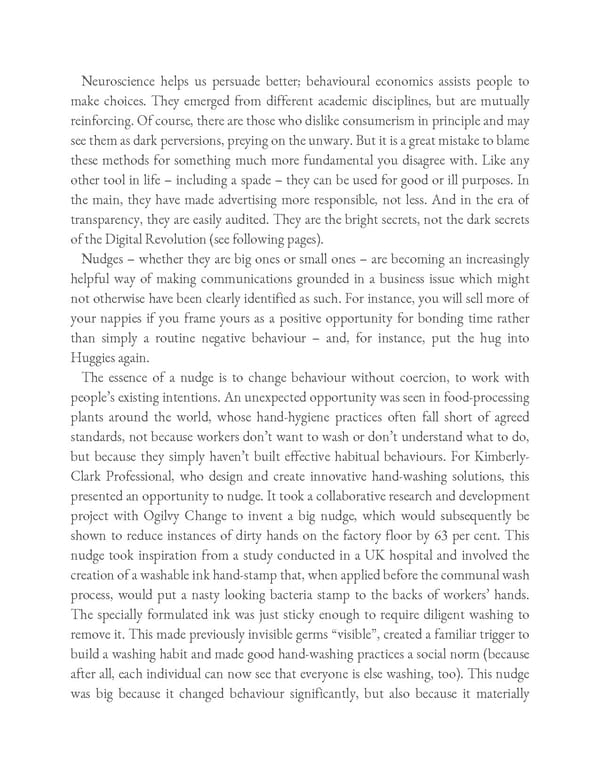Neuroscience helps us persuade better; behavioural economics assists people to make choices. They emerged from different academic disciplines, but are mutually reinforcing. Of course, there are those who dislike consumerism in principle and may see them as dark perversions, preying on the unwary. But it is a great mistake to blame these methods for something much more fundamental you disagree with. Like any other tool in life – including a spade – they can be used for good or ill purposes. In the main, they have made advertising more responsible, not less. And in the era of transparency, they are easily audited. They are the bright secrets, not the dark secrets of the Digital Revolution (see following pages). Nudges – whether they are big ones or small ones – are becoming an increasingly helpful way of making communications grounded in a business issue which might not otherwise have been clearly identified as such. For instance, you will sell more of your nappies if you frame yours as a positive opportunity for bonding time rather than simply a routine negative behaviour – and, for instance, put the hug into Huggies again. The essence of a nudge is to change behaviour without coercion, to work with people’s existing intentions. An unexpected opportunity was seen in food-processing plants around the world, whose hand-hygiene practices often fall short of agreed standards, not because workers don’t want to wash or don’t understand what to do, but because they simply haven’t built effective habitual behaviours. For Kimberly- Clark Professional, who design and create innovative hand-washing solutions, this presented an opportunity to nudge. It took a collaborative research and development project with Ogilvy Change to invent a big nudge, which would subsequently be shown to reduce instances of dirty hands on the factory floor by 63 per cent. This nudge took inspiration from a study conducted in a UK hospital and involved the creation of a washable ink hand-stamp that, when applied before the communal wash process, would put a nasty looking bacteria stamp to the backs of workers’ hands. The specially formulated ink was just sticky enough to require diligent washing to remove it. This made previously invisible germs “visible”, created a familiar trigger to build a washing habit and made good hand-washing practices a social norm (because after all, each individual can now see that everyone is else washing, too). This nudge was big because it changed behaviour significantly, but also because it materially
 Ogilvy on Advertising in the Digital Age Page 406 Page 408
Ogilvy on Advertising in the Digital Age Page 406 Page 408